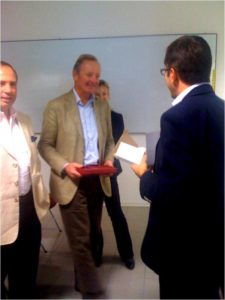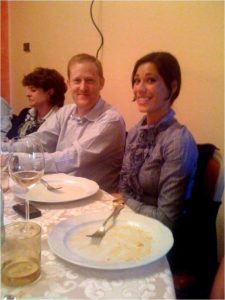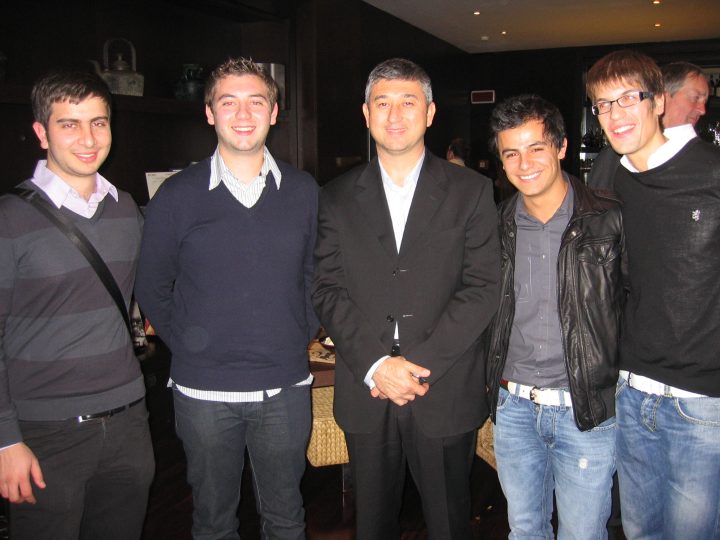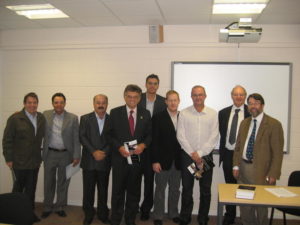POSTED ON Three items below
In Bologna with the Master of Leathersellers

You might have expected that the recession would have meant real problems for the Trade Shows. Yet the need to know what is happening and to get this knowledge first hand has forced the key players in the leather industry to keep travelling. It was thus in Shanghai and no less in Bologna for Lineapelle. Certainly in Bologna the first and last days were quieter but no one complained that we met and the meetings were all good.

It was one of the best shows for the BSLT. With the BSLT/UON brand strong and a lot happening after a busy summer centenary Lynn Margetts from the alumni office arranged a small party on the middle day at the Star Hotel Excelsior just opposite the station. Designed as a place for alumni and friends to drop by after dinner on the way to the station or to dinner it worked exceptionally well and was very well attended. The Master of the Leathersellers Company, Mr. Charles Barrow, was in Bologna and attended to have a conversation with all those present. As a “Barrow, Hepburn and Gale” Barrow he reminded us of the strong British history of tanning and it world wide dominance in older times.
Indeed the day before Dr. Mark Wilkinson and Dr. Jeffry Guthrie-Strachan travelled with the Master and Clerk to Arzignano for an extensive day of visits on education, tanning, tanning machinery, and environmental treatments. Mauro Magnaguagno of the TFL Academy put together this busy day with Jeffry and of course our good friend Antonio Galiotto put his customary passion into the increasingly important aspect of what modern machinery can do for the leather industry. An intensive day of industrial tourism; but an excellent opportunity to cement relationships in Northern Italy.
Students and the Future

One excellent aspect of this visit, and indeed in Bologna as well, was the presence of current students. We have not seen much of current students on our travels in previous years and it is certainly something we must hope can continue.
Meanwhile back at the office we have the lobby and classrooms updated to match the tannery improvements. While long term plans are still evolving the next phase of the tannery – the finishing – is in final planning.
So at the same time as a lot is happening in the industry a lot is happening also at the BSLT and in many ways the two are very much in harmony, as the courses and research evolve steadily to meet industry requirements. The development of a more biologically based industry, with greater involvement in turning its wastes into assets, and much more properly understood innovation all allied to the needs of increasingly time deficient executives.
While the industry, especially furniture and auto, has felt the recession it has been less than we feared. But it has got everyone steeled to make significant changes to develop a much stronger future.
Mike Redwood
24 October 2009
POSTED ON
Speech at Opening of the 30th IULTCS Congress in Beijing, China
Elton Hurlow has long had a good understanding of the issues in the leather industry. This is his speech at the opening of the IULTCS which has just started in Beijing:…………..
Members of the IULTCS, Delegates, Honorary Guests, Ladies and Gentlemen,
Leather as a Component Brand
It is my distinct honour to address you at the opening of this week’s grand celebration of the science and technology that surrounds the making of leather. Our industry takes a renewable natural raw material – which comes to us as another industry’s waste by-product – and we turn it into a durable, aesthetically pleasing, and versatile structural material highly valued by leading brands of consumer articles. Our secret is that we have the privilege of working with one of natures most unique materials – collagen. Collagen comes to us in the form of twisted triple helical strands, which we then purify and build upon that framework. Our industry at once resolves a disposal problem and simultaneously creates a highly valued and useful product. We should actually use the word intermediate product as leather is typically a component of what the consumer buys. I suggest we describe leather as a component brand, as leather is the identifier of value. At retail, sales people always refer to their article as a leather jacket, a leather sofa, a leather shoe, or a car with leather interior. They add the word leather because it evokes a favourable emotional response in the mind of the consumer – it elicits feelings of aesthetic pleasure, it appeals to the visual, tactile & olfactory senses. The mind conjures expectations of performance and durability, and there is an overwhelming sense of intrinsic value. What a wonderful industry we work in, and this week we are here to celebrate the global knowledge surrounding collagen and its transformation into the component brand “leather“.
Value Chain Issues
Over the last two years, I have reflected on my concerns surrounding two important aspects of the leather value chain. One is the Identity of leather and the second is the Image of the industry. Let me add that my concerns are NOT unique and are shared by other individuals and organizations involved in the leather industry.
1) Let’s look first at the “Identity of Leather“:
As scientists, we are uniquely qualified to answer the question: “What is leather?” I think we also need to reflect on the question: “What is NOT leather?” For what is leather, how it is labelled, and how it is understood at point of retail goes to the very heart of what it takes to maintain leather’s fundamental value. You just have to walk into any department store today to understand that leather is under threat by “What is NOT leather”. Substitutes add the word leather to elevate perceived value in the eye of the unwary consumer using terms “synthetic leather”, “leather-like”, “faux-leather”, “composite leather” etc. These are not leather. Also, leathers of poor quality, those only made “good enough for purpose” or “to price point” also devalue the component brand by exhibiting poor performance and can result in a negative consumer experience.
So what can we do about it?
I suggest the first point is awareness. As technical individuals and as an organization we can offer support to those agencies such as ICT, Cotance, national bodies such as the CLIA that are working to differentiate leathers by implementing labelling and identification standards. Our institutes can also do research and publish work on re-cycling, sustainability, renewability and the other positive contributions of the leather industry. As scientists, we can clearly identify and should communicate the unique performance properties of leather. We must support high leather standards. We should celebrate those who excel and recognize their achievements. We should support those who work to raise the perceived value of leather and protect its unique and valued identity in the minds of end consumers.
2)Let’s talk briefly now about the “Image of the Industry“:
The image of the global tanning industry can be improved, especially with regard to pollution and environmental sustainability. It is not just from a moral and ethical viewpoint that we need to be good stewards of the environment, but a business case can also be made for sustainability in manufacturing. The technology exists to manufacture leather in a clean and environmentally sound way. Many companies do. But the actions of a few can override the good behaviour of many.
To improve our record will take concerted actions of individuals, organizations, and, because of the costs this involve, it will most likely take pressure from governments and regulators and we hope will include the support of brand conscious retail. Implementation of minimum standards and attainment of best practice guidelines takes time, money and effort. The IULTCS and its members can assist with continued research, technical support, knowledge transfer, and efforts aimed at benchmarking and recognition of those who do succeed in running clean operations. There are in fact many positive examples of this happening worldwide. The IULTCS needs to support these efforts.
A positive and cleaner image is also important to entice talented young people to study leather, and join our industry. We should also recognize those leather training organizations that have programs in place to educate young fashion designers and stylists about the wonderful story of genuine leather, its unique performance and aesthetic properties, and how to work with it.
Now, to the IDENTITY of Leather and the IMAGE of the Industry, I am going to add INNOVATION in leather making.
3)”Innovation in Leather making“:
Innovation comes in different forms. It is not always the strong forces of “creative destruction” that can rapidly overturn the old ways and herald in the new. In my 25 years of leather industry experience, innovation has typically been incremental and adopted slowly. Machinery operates today on pretty much the same basic principles as two decades ago; but small design changes, introduction of electronics and computerized controls have resulted in great improvements. Chemical principles of making leather are essentially the same as years past; but the introduction of new products such as polymeric lubricants, stucco, new finishing technologies, have improved efficiency and performance. We have also seen improvements in waste treatment methods, tanning recipes, work practices, handling methods – these are all examples of continued creativity and innovation in the leather industry. The IULTCS this week will celebrate innovative solutions to problems, new ideas will come from lectures and personal interactions, and better understanding of our working materials and how to do things will evolve. Innovation drives efficiency, solves problems and opens new markets.
The IULTCS and its represented members are uniquely qualified to make major contributions in the area of Innovation, and this is the main reason we are here this week.
Beijing 0ctober 2009
Madam Zhang, Mr Su, Prof. Shi Bi and the rest of the organizing committee, we thank you for your hard work in preparation for this Olympics of leather technology. There is much significance surrounding this 30th IULTCS Global Congress. The first IULTCS Congress was held 60 years ago in Paris in 1949. During the 110-year history of our Union, this is only the second time that an IULTCS Congress will be held in Asia, and the first time in China. Today, China is a global leader in the production of leather, and her scientists and technicians make significant contributions toward the research and development of new technologies for leather manufacture. I ask that we focus this week on what I believe are three very important needs of our industry:
- The Identity of Leather,
- The Image of our Industry,
- And Innovation in the leather making process
This is important to maintain value in our industry. Thank you.
Elton Hurlow
President – IULTCS
October 2009
POSTED ON
Leather Chemists are a danger to Society
The start of a new academic year is always a bit chaotic but this year you have to feel for all the staff at the BSLT. As the new students arrived there was total confusion caused by the new Home Office Visa rules taking applications that used to take days into weeks and months. Did you ever realise that every leather chemist was a potential threat to the UK? On reflection I should withdraw that question: I had enough problems at University myself. The Government does need to do something about this. Pakistan has been sending students to the UK for all of the 100 years of leather education, has a huge raw material supply underpinning a major leather industry, and one or two really world class leather organisations.
At the same time the refurbishment of the teaching rooms and the lobby is just completing. Luckily enough has been done for all the rooms to be used and are already looking like a huge improvement, but there is a lot of tidying up and completion yet to be done.
It is good to see a steady growth in European students with France and Italy beginning to figure quite strongly. We have not made a breakthrough into the old East European countries yet, which is a disappointment given that they all have strong historical interests in leather and significant industries today. Also with the growing strength of the www.northamptonshireleather.com activity and the ability of the University to address the whole supply chain might well start to get UK students coming in who are not affiliated to major tanneries as in the past. The leather industry is really a very exciting place to work.

In amongst al this it was delight to welcome a senior delegation from the Brazilian leather industry, and to realise how much there is to show such a group not only in the University but in Northampton as a whole. They did visit the BLC and SATRA as well as the BSLT but with the University alone also having Waste Management, Fashion, Product Design, Podiatry and the Leather Conservation centre a couple of hours in the Leathersellers Building is hardly enough. Northampton with 100 leather organisations in the county is now actually a great destination for anyone in the leather industry planning a visit with time to let us know.
Hopefully the President of the CICB (Brazilian Tanners Association) Mr Wolfgang Goerlich and his team enjoyed their visit. It was certainly entertaining and useful for the University and the BSLT to join with them to discuss environmental issues, research and some of the global issues in the industry these days.
And particularly good to have a better looking facility to do it all in. Progress can be good.
Mike Redwood
05 October 2009